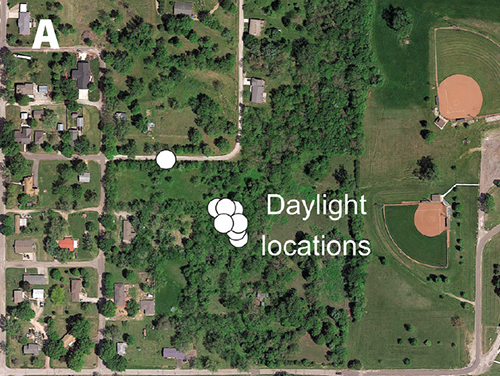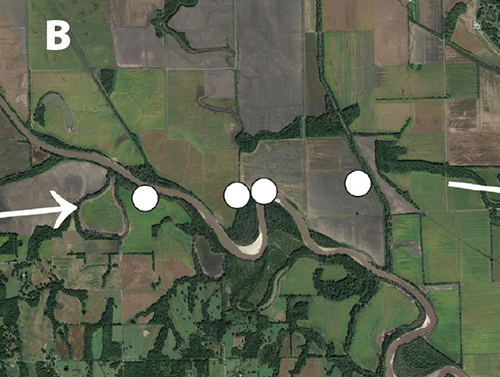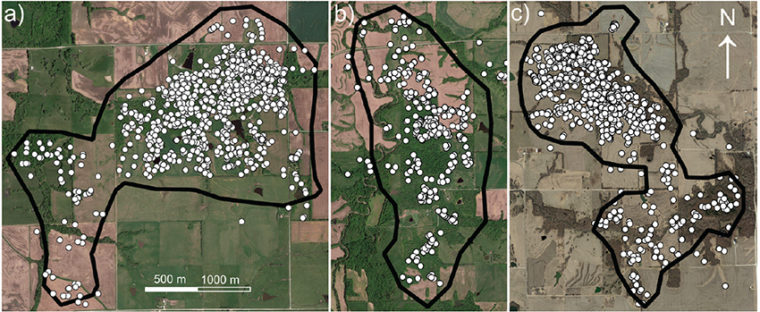it’s difficult to trap a good deer scientist. They leave themselves room to maneuver when you ask them for certainty about deer behavior, a sort of scientific CYA. Good deer scientists say “usually” instead of “always” and “rarely” instead of “never.” When a good “yes” or “no” is what you desire, they say “It depends.” And they should. Though we know a lot about the average deer’s biology and behavior, there are always rare exceptions.
This is the story of an exceptional buck and his mysterious adventure.
A responsible deer scientist will tell you most bucks disperse from their birth range, usually around 1½ years of age, and set up a permanent adult home range which they rarely abandon. That adult home range might have seasonal compartments, but the majority of adult bucks are done with dispersal and will likely die in or near that adult home range. Did you notice my own CYA in italics? Those words are necessary because of bucks like N17003.
By all odds he should not have done this: He left his adult home range in northwest Missouri on November 4, 2017, and traveled 186 miles over 22 days, an average of more than 8 miles per day. That distance in a straight line could have taken the buck across the entire width of northern Missouri and well into Illinois. As it was, the straight-line distance from start to finish of 134 miles is more than five times the next closest adult buck dispersal movement in scientific records, 25 miles. The map below shows the entire trip.
Why did a 3½-year-old Missouri buck take off during the peak of the rut and truck rapidly across an entire state during hunting season? That’s what Dr. Remington Moll of the University of New Hampshire tried to learn by analyzing all the data collected on the buck’s GPS tracking collar. (Dr. Moll goes by Rem for short, but when a deer scientist has a name like Remington, we’ve got space on this deer-hunting website to spell it out). We know a lot about the buck and his road trip thanks to the collar, but there are large pieces of the puzzle missing. Follow along as I describe the clues Remington had to work with.
Captured
Each winter from 2015 to 2019, researchers from the University of Missouri, in partnership with the Missouri Department of Conservation (MDC), captured and collared whitetails for an extensive study of deer survival, movement and habitat selection. Dr. Josh Millspaugh and Dr. John McRoberts, both now at the University of Montana, oversaw the capture of more than 700 deer between two focal areas in north and south Missouri.
On January 26, 2017, technicians working in northwest Missouri launched a rocket net and captured buck No. N17003. They handled, measured and collared him. Technicians noted he appeared to be in good health with no injuries or outward signs of disease or parasites. They examined his teeth and estimated him to be 2½ years old at the time. After 10 minutes of handling, they released him.
If you’re going to play along in this game of Clue, it’s important to know the age estimate of 2½ is likely very accurate. Fawns and yearlings (1½-year-olds) are easy to spot with almost 100% accuracy because of tooth replacement patterns. You don’t need to look at tooth wear to spot a yearling. Plus, studies have shown that estimating age from tooth wear is accurate out to age 3½. So, while the buck might have been older than 2½ when captured, it’s extremely unlikely he was younger. In short, he was already an adult buck when captured.
If it was hunting pressure that sparked this trip, the buck over-corrected. He didn’t just leave his home range. He didn’t just leave the county. He went to a different corner of the state!
Spring and Summer 2017
The buck’s GPS collar showed him initially using a home range of 1,010 acres that was about 19% forested. That’s slightly more than average forestation in this part of Missouri, where the landscape is about 12% forest, 45% agriculture, and 38% pasture and CRP grassland. But on September 4, he drifted north about 5 miles and started occupying a new sector 783 acres in size and about 40% forest. He would stay there for two months.
This shift northward a few miles is not unusual. Numerous examples from GPS-collar studies show bucks shifting focal areas within an established home range or even departing to separate “rut ranges” that are as much as a few miles distant from where they spend the rest of the year. The shift occurred on September 4, and Missouri’s archery season opened on September 15 that year. Did scouting and stand-hanging activity, a shift in food resources, or the rise in testosterone preceding the rut push the buck to a separate breeding range? We can only guess.
A Rare Event
The fall range shift in September was nothing that would have caught a researcher’s attention, but it was a mere warm-up for the buck. The big move began on November 4. Through that night, N17003 traveled another half dozen miles north and stopped in a small wooded area inside the city limits of the small town of Stanberry, Missouri (see below). He spent the daylight hours there, moving little, then set out again as darkness fell. This wasn’t another range shift. It was the beginning of a travel-by-night pattern that would last the next 22 days.

The buck typically spent daylight hours in small patches of cover, like this small green-space between neighborhoods and ball fields in the town of Stanberry, Missouri. See reference point A on the large map.
Shortly after leaving Stanberry in the dark, the buck crossed a 20-yard-wide branch of the Grand River. Ultimately, he would cross the river six more times before the journey was over, in places with a width around 100 yards. He would follow the river’s course at times, and other times not, but the Grand River was not a barrier to him. He crossed it seven times at night with no problem.
After curving eastward, on November 10 he was in the town of Bethany, Missouri and close to Interstate 35, which runs north from Kansas City to Des Moines, Iowa. At sunset on the day before opening day of rifle season, the buck set out down the Interstate and traveled nearly 9 miles south, then he holed up in a small patch of cover close to the highway, where he spent opening day. As the sun set again, he crossed Interstate 35 and continued southeast.
He was traveling through (we assume) unfamiliar country in gun season. But his travel pattern continued to suggest a buck who was aware of the danger. By night, he trucked. In addition to the river and the Interstate, he crossed a railroad and eight state highways, some of which were four-lanes. By day, he sheltered in small patches of forest surrounded by open farm fields or tucked in close to suburban areas.

Seven times during the trip, the buck encountered the Grand River and crossed it in the dark. In places where he crossed, the river was as much as 100 yards wide. See reference point B on the large map.
On the evening of November 25, almost a month and nearly 200 miles after departure, the GPS collar stopped its east-southeast movement. The buck had arrived – somewhere. A new – “new” as far as we know – home range started to take shape over the next few weeks. It covered 793 acres and was 19% forested, much like the two ranges he’d left behind.
His journey began less than a year after he was collared. Unfortunately, there’s not much post-journey life to examine either. On June 20, 2018, seven months after he arrived at his new home range, his GPS collar stopped moving and started sending a “mortality” signal. According to Jon McRoberts, the buck was fairly decomposed when he found it. The date of death in late June, and the location of the carcass near water, suggested the buck died of hemorrhagic disease (EHD or bluetongue virus). But even that is not certain.
Fascinating Travel Habits
After the buck died, and because he exhibited such unusual behavior, Remington carefully analyzed the buck’s entire trip through data in the GPS collar, digging into small-scale movement patterns that aren’t obvious from looking at a string of GPS waypoints on a map.
For example, when he was traveling, the buck covered much more ground than normal. In his home ranges before and after the long dispersal, the buck averaged 62 yards per hour in daily movement. During the dispersal, he averaged 621 yards per hour: 10 times as much.
During the dispersal, he clearly favored darkness for traveling. In the day, he averaged 181 yards per hour, while at night it was 927, or five times the rate. And it’s clear he looked for forested cover in which to hide during the day: 57% of his daytime locations were in forested cover, while at night he spent about 20% of his time in the woods. Remember the region averages about 12% forested cover, so his night moves were more like cross-country tours, while he seemed to make an effort to select forested cover during the day.

The buck arrived before dawn at this small patch of woods surrounded by agriculture and departed again at sunset. Over 22 days, he never stayed in the same spot two nights in a row. See reference point C on the large map.
Finally, Remington analyzed the buck’s “turning angle,” or how often he changed direction left or right on a fine scale. Turning angles run high inside a deer’s home range, where an animal is browsing, returning to cover, and otherwise circulating around inside fairly solid boundaries. On the dispersal, the buck traveled as if he had a destination in mind and wanted to get there soon. His turning angles were very low. They were especially low at night, as he traveled, and somewhat higher in the day, as he hid. He was not motionless during the day, but his lower rates of movement and higher turning angles suggest this was when he looked for food.
Now you know most of the major clues. Let’s consider some of the explanations for this extreme dispersal.
Was it About Habitat?
“From a habitat perspective, there’s nothing unique about the place he stopped,” said Remington. “I would love to know what made him stop where he did.”
The buck ended his trip in a landscape similar to where he started. There’s no remarkable difference in habitat quality, deer herd characteristics, hunting pressure or other factors. And I find it hard to believe you can cross 186 miles of terrain in northern Missouri before you find land with high-quality deer habitat. But again, the buck did not appear to be range-shopping as he moved.
“There could have been a little bit of exploratory movements that aren’t quite captured in this data, but it’s not like he stops for a few days,” said Remington. “Every day he continued moving. Those cues that finally caused him to stop? it’s hard to say.”
Back Home Again?
Because the buck was captured at age 2½, we don’t know where he was born. If he did what most yearling bucks do, then he had already dispersed from his birth range more than a year before he was captured. it’s possible his big dispersal was his second time running this route, and he was simply returning home. But this would be another extreme oddity: Yearling-buck dispersals aren’t known to run in reverse.
Was it About Breeding?
Some might suggest the buck was leaving an area of high rut competition to find better breeding opportunities elsewhere. This theory doesn’t make a lot of sense to me. The stretch from November 4 to 25, while the buck was traveling at warp speed, captures the majority of breeding dates in northern Missouri. He missed the peak of the party during his travels! If an estrus doe was his desire, why did he pass through the scent trails of dozens if not hundreds of them without turning aside? His movement patterns on the trip leave no evidence of courtship, one-night stands, or even stopping at a local bar to see who was there. He hid in the day and made tracks in straight lines in the dark.

“Turning angle” is a measure of changes in direction left or right. Low turning angle at night indicated the buck was traveling hard in straight lines. His turning angle ranged higher in the day as he held tight in small pockets of cover, foraged, and rested. If this was a trip about finding does or better habitat, he didn’t spend much time looking around as he traveled.
Was it About Hunting Pressure?
Given the timing, this is something to consider. The buck departed for the big trip on November 4 during archery season and seven days before the opening of firearms season. Hunting activity was not measured, but it’s safe to assume noticeable pressure given Missouri’s half-million licensed deer hunters.
My problem with this theory: If it was hunting pressure that sparked this trip, the buck over-corrected. He didn’t just leave his home range. He didn’t just leave the county. He went to a different corner of the state!
Also, if hunting pressure forced him to depart, it seems to me he would spend a little time surveying the countryside on his trip to evaluate conditions and determine a new home. But his movements for 22 days do not suggest this was an exploratory trip. He traveled fast in straight lines at night, and hid and fed a little during the day. He never spent two nights in the same area, for 22 days. It was as if the destination was known.

Three home ranges the buck occupied while wearing a GPS collar: A and B were pre-dispersal, and C was after the 186-mile trip. All three were close in size, similar in habitat, and had no known differences in hunting pressure or deer herd characteristics. If there was something special about the last one that attracted the buck from 134 miles away, only he knew what it was.
Was He Sick?
Missouri is a chronic wasting disease (CWD) state. In fact, one of the purposes of this study was to better understand deer movements to help manage the spread of CWD. However, the buck’s starting point is not in a CWD zone, and CWD has not been detected close to his route. Generally, deer that are infected with CWD tend to move less over time as the disease develops, not more. it’s unlikely CWD was a factor in his behavior.
Disease Implications
The story of N17003 would be just be a wild tale for deer-camp discussion except for one thing: It has implications for disease management, especially CWD. This buck’s trip was an extremely rare event, but if the deer making such a trip happens to carry CWD into a new area, the impact might be significant.
“This buck was one of 700 animals tracked in this study, but there’s over a million deer in Missouri,” said Remington. “Even if this is happening once in every 10,000 animals, it’s potentially happening a hundred times a year. It seems like a very, very rare event, but we collar such a small proportion of the population that it’s hard to say how rare it is in reality.”
Lessons from a Rogue Buck
Yearling dispersal and brief excursions by adult bucks and does serve at least one significant benefit to a deer population: They ensure genetic diversity through gene flow across the landscape. Because these are risky behaviors, though, there’s a dance between gene distribution and home-range loyalty. Dispersal mostly occurs once in a deer’s lifetime and at a young age, after which they settle into a familiar range where they can easily find food, water, breeding opportunities and escape cover.
These are accepted behavioral norms that have been documented repeatedly in scientific research, but the Missouri buck proved they are not strict rules. Home ranges are not bounded by brick walls. Dispersal might or might not happen, it might involve a range of distances, and it might sometimes occur among adults. There are always rare outliers, both in behavior and in DNA, that introduce variations that may improve survival. N17003 was probably that kind of pioneer.
We don’t need to change our understanding of managing and hunting deer because of this buck’s adventure. As this organization has said before: We manage deer populations, not individual deer, and the norms of behavior give us the best understanding of how to do that.
One wild outlier doesn’t change our deer management advice, but it sure makes for an interesting mystery to fuel new firepot stories. Let me know when your deer-camp crew solves it.

